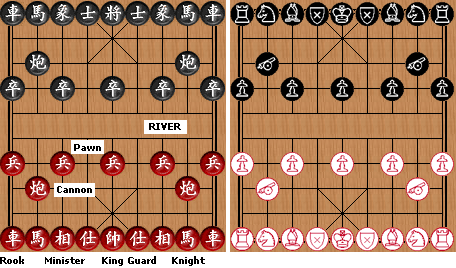Chinese Chess Rules
Chinese Chess Rules consist of three parts: (1) the basic
rules telling which moves are allowed; (2) the advanced rules
restricting certain moves to ensure fair games; (3) the drawing
rules preventing games from being too long

Chinese Chess Basic Rules
One can move the pieces according to the following rules:
1. The King moves only one space at a time,
either horizontally or vertically. Furthermore, the King must
always stay within the palace , which is a square marked with
an X.
2. The Guards (Advisor) move only one space
at a time diagonally. Similar to the King, the guards must
stay within the palace.
3. The Ministers (Elephants) move two spaces
at a time diagonally (i.e. 2 spaces left/right and 2 spaces
up/down in a move). They must stay within their own side of
the river. If there is a piece midway between the original
and final intended position of a minister, the minister is
blocked and the move is not allowed.
4. The Rooks (Cars) move one or more spaces
horizontally or vertically provided that all positions between
the original and final positions are empty.
5. The Knights (Horses) move two spaces horizontally
and one space vertically (or respectively 2 spaces vertically
and one space horizontally). If there is a piece next to the
horse in the horizontal (vertical) direction, the horse is
blocked and the move is not allowed.
6. The Cannons move one or more spaces horizontally
or vertically like a Rook. However, in a capture move, there
must be exactly one non-empty space in between the original
and final position. In a non-capture move, all spaces in between
must be empty.
7. The Pawns (or Soldiers) move one space
at a time. If a pawn does not cross the river yet, it can
only move forward vertically. Once crossing the river, the
pawn can also move horizontally.
8. Capture: When a piece moves to a position
currently held by an opponent's piece, it captures that opponent's
piece. The captured piece is removed from the board.
9. King's line of sight: The two Kings in
the board must never be on the same file (vertical line) without
any pieces in between them. A move that puts the two Kings
in such a setting is illegal.
10. King safety: One must never leave the
King to be captured by the opponent in the next move. Any
moves that put the King in such a setting is illegal.
End game condition: The game ends when one
of the following situations happens:
* Checkmate: If one threatens to capture the opponent's
King and the opponent has no way to resolve the threat, one
wins.
* Stalemate: If one does not have any valid move, one loses.
* One or both sides violate the Advanced Rules . |

